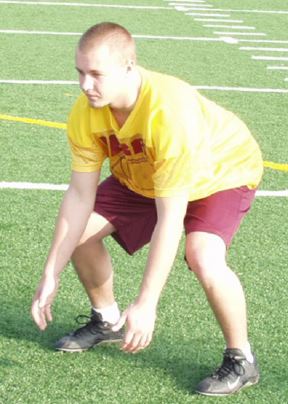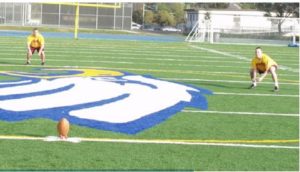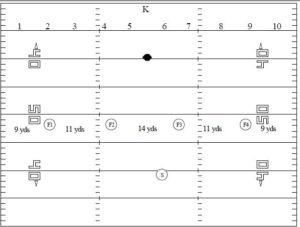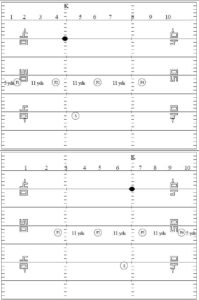This is the second of a two part series on kickoff returns. Click this link to read: Kickoff Returns Part 1
TECHNIQUES
Schemes are only one component of putting together a quality return package. The selections of players, keeping blocking schemes simple and using proper blocking technique are critical components to a successful return team. This section will discuss personnel, alignment, numbering theory and open field blocking.
PERSONNEL
Good players will make a good scheme great. Players with the ability to run that have good hip flexibility, and the willingness to make open field blocks are kickoff return team material. Therefore, the Pride and Joy players are picked for specific skills. The positions and qualities are:
 Front: These players must be able to run because they have to run to a cutoff or block point. They must be willing to be physical at the point of attack. No blocks in the back. They must be smart because they are the primary players that adjust to the different kickoff formations. They must also be disciplined – watch the ball being kicked before retreating. Their stance is a balanced football position; feet slightly wider than shoulder width, with the knees flexed aligning the shoulder, knees and toes. They are a ¼ turn inside; i.e., the outside foot is closer to the kickoff team. The hands are loosely hung inside the knees, similar to a baseball infielder. This position allows them to make a play on ball kicked directly at them.
Front: These players must be able to run because they have to run to a cutoff or block point. They must be willing to be physical at the point of attack. No blocks in the back. They must be smart because they are the primary players that adjust to the different kickoff formations. They must also be disciplined – watch the ball being kicked before retreating. Their stance is a balanced football position; feet slightly wider than shoulder width, with the knees flexed aligning the shoulder, knees and toes. They are a ¼ turn inside; i.e., the outside foot is closer to the kickoff team. The hands are loosely hung inside the knees, similar to a baseball infielder. This position allows them to make a play on ball kicked directly at them.
Short: This player must have the same characteristics as the Front, but can be a step slower since they are aligned 5-yards deeper than the Front. They must also be disciplined by watching for the surprise onside kick. Their stance is a balanced football position, square to the kickoff team. They must be ready to charge forward in case of a surprise onside kick.
Wings: These players must be able to run and HIT. They have crossfield (blindside) blocks on most of our returns. They must have a nasty streak! Also, they have to be able to handle the pop kick, either catch and run, or fair catch. Their stance is a balanced football position; feet slightly wider than shoulder width, with the knees flexed aligning the shoulder, knees and toes. They are a ¼ turn inside; i.e., the outside foot is closer to the kickoff team. The hands can be relaxed on the thighs.
Middle: This player is very similar to the Wings, except they do not necessarily have to be as fast, because they do not have to run as far as the Wings. They should be a bigger football player. The size will help them because they are point on wedge blocking schemes, and a critical blocker on the sideline returns. They must be athletic enough to catch the football on the run and return it for positive yards. Their stance is a balanced football position, square to the kickoff team.
Backs: These players must be athletic. They must be able to catch the football on the run, either backing up or running forward. They must be able to handle the football without fumbling. They must be outstanding, and committed blockers because if they do not get the ball, they will collide with a kickoff defender at high speeds. Their stance is a balanced football position; feet slightly wider than shoulder width, with the knees flexed aligning the shoulder, knees and toes. They are a ¼ turn inside; i.e., the outside foot is closer to the kickoff team. The hands can be relaxed on the thighs.
Returner: This player is very similar to the Backs, but is better at making tacklers miss. They must be fearless in running, with blind faith that the holes will open, never slowing down upon contact. Their stance is more erect, feet balanced with a slight bend in the knees. They must be able to run to catch or to get the ball.
ALIGNMENT
Most teams use a five-man front line. We prefer to use four because so many teams are now kicking from the hash mark. This allows us to align more of our players a little farther from the kicking team, which results in better timing of blocks to spring the returner. The risk is that teams feel that they can execute surprise onside kicks, or short pop kicks. We drill these situations every time the Pride and Joy Team works. We feel that if a team wants to give us the ball on the 50, we will take it!

Our Front players will align on the minus-49 yard line. They will position themselves to provide a gap of approximately eleven yards between the middle players and the football. As the kickoff team aligns, the sideline players will yell “alert, alert”, and the Front will echo it back to the sideline. This is a reminder for the Front players to see the ball kicked before they begin to retreat to execute their blocks.
The Short player always aligns in front of the kicker, offset by one yard to the field with their heels fifteen yards from (minus-45 for high school or 50 for college) the kicker. The Front and Short players are the only players that typically adjust to the kicking teams formations. Here are the examples of the adjustments to ball location by the front five:
Diagrams of Front/Short alignments versus three possible ball placements.

When the ball is in the middle of the field, the front four will align to cover the field. The gap between the two inside players is slightly wider; therefore the Short player must be more aware of the possible surprise onside kick.

When the ball is on the left hash mark, F2 moves to two yards inside the hash, and F3 splits the distance between the hash marks. This creates a gap of approximately eleven yards. F1 aligns 5 yards from the sideline, and F4 aligns 2 yards outside the far hash.
Short will align one yard inside the hash to the field.
When the ball is on the right hash mark, F3 moves to two yards inside the hash, and F2 splits the distance between the hash marks. This creates a gap of approximately eleven yards. F4 aligns 5 yards from the sideline, and F1 aligns 2 yards outside the far hash.
Short will align one yard inside the hash to the field.
The Wings are aligned four yards outside the hash marks, with their toes on the minus 35-yard line. The Wings must be aware of possible pop kicks, especially when a team is kicking from a hash since the away Front player has moved farther from the sideline. As such, the Wings must take a step forward making sure that ball is kicked deep before they retreat to execute their assignment. If a team attempts a crossfield pop kick, the Wing must run forward, signaling for a fair catch, and catch the ball. The kickoff team cannot interfere with the Wing’s right to catch ball, as long as the ball has not hit the ground. If the Wing signals a fair catch, and the ball hits the ground it is a live ball, so the Wing must recover the ball. They cannot advance it, if they have signaled a fair catch.
The Middle player aligns in the middle of the field with their heels on the minus-20 yard line. The Middle player must be aware of crossfield kicks and should field all kicks between minus-35 and minus-20.
The Backs align two yards outside the hash marks, with their toes on the minus-15 yard line. The Backs must field all kicks from the minus-20 to the goal line, on their side of the hash. If the Returner calls them off, then they will execute their blocking responsibilities.
The Returner aligns in the middle of the field, with their toes on the minus-5 yard line. The Returner will shade based upon scouting reports. They must return every kick that they can get to.
About the Author of this post:
Jerry Campbell has over 30 years of high school and college coaching experience. He has experience as a head coach, offensive coordinator, and various position coaches. He has written numerous football coaching articles in various publications, is the author of over 30 books on coaching football, and has produced 12 coaching video series. Additionally, he is a nationally sought after speaker on the coaching clinic circuit.